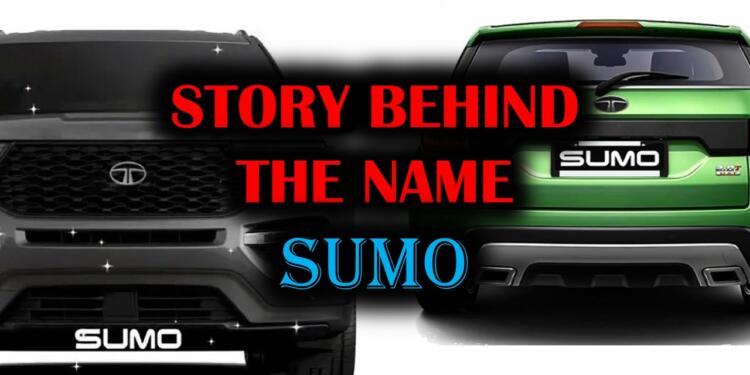Tata Sumo car story: In the realm of iconic vehicles, one name stands tall: Tata Sumo. Evoking memories of the 90s, this impressive Multi-Utility Vehicle (MUV) was once a coveted status symbol for many Indian states. But hold on to your preconceptions, as the truth behind its name is far from what you might expect. Contrary to popular belief, Tata Sumo is not named after the colossal wrestlers of Japan.
In this Article, we embark on a journey to unravel the mystery behind the name, exploring the minds and motivations of the visionaries who christened this automotive marvel. Prepare to be intrigued, for the truth behind Tata Sumo is a testament to the blending of heritage and innovation, defying expectations and inviting us to question the assumptions we hold dear. So, buckle up, and get ready to discover a fascinating aspect of automotive history that has remained hidden in plain sight for far too long.
Story: The Emergence of Tata Sumo:
Story behind Tata Sumo was born in the early 1990s when India was witnessing a transformation in its automotive landscape. The demand for utility vehicles was on the rise, and Tata Motors, previously known as TELCO (Tata Engineering and Locomotive Co. Ltd.), aimed to make a significant impact in this segment. As the company set out to develop its first MUV, a team of talented engineers and designers was assembled, led by the visionary Sumant Moolgaonkar.
Sumant Moolgaonkar, the chief designer at TELCO, was renowned for his design prowess and forward-thinking approach. He had already played a vital role in shaping some of Tata’s most successful commercial vehicles. His reputation as a pragmatic and empathetic designer earned him the respect of his colleagues and the top management.
The Curious Lunch Breaks:
However, it was during the lunch hours that Sumant’s unique approach to design came to the fore. Rather than joining his colleagues in the office canteen or dining at upscale restaurants, Sumant would quietly slip away from the premises. This behavior raised eyebrows and led to rumors and speculations among his colleagues. Some speculated that Sumant might be meeting Tata dealers or accepting lavish lunches at posh hotels as bribes.
To quell the rumors and ascertain the truth, the management initiated a campaign to investigate Sumant’s mysterious lunchtime escapades. They decided to follow him discreetly to uncover his secret activities outside the office.
However, when the management discreetly followed Sumant, they were in for a surprise. Instead of finding him at a fancy five-star hotel or in the company of influential people, they found his car parked at a humble highway dhaba. To their astonishment, Sumant was having lunch with truck drivers.
The revelation shed light on Sumant’s true intentions. He was not indulging in any illicit activities but rather engaging in a thoughtful and empathetic act. Sumant was using his lunch breaks to interact with truck drivers, seeking their feedback about Tata trucks and learning about the issues they faced during their journeys.
Also read: 5 Accidental Inventions that have become essential in our lives
The Empathetic Designer:
Sumant’s genuine interest in understanding the problems faced by truck drivers demonstrated his commitment to improving the vehicles he designed. He believed that the best way to enhance Tata’s trucks was to gather insights from those who spent long hours on the roads, experiencing the vehicles’ performance firsthand.
During these candid conversations, Sumant gained valuable insights into the challenges faced by truck drivers. He listened attentively to their feedback, understanding their needs and preferences. Armed with this invaluable knowledge, he returned to the office after lunch and shared his findings with the research and development (R&D) team at TELCO.
The Birth of Tata Sumo:
Sumant’s approach of engaging with real users and incorporating their feedback into the design process struck a chord with the top management. They realized the value of this customer-centric approach and saw it as a defining aspect of their product development strategy.
Recognizing Sumant’s exceptional dedication and the positive impact his actions had on Tata’s products, the management decided to honor him by naming the new MUV after him. Tata Sumo was born, and it quickly gained popularity as one of the first proper MUVs made, assembled, and promoted in India.
Though Sumant Moolgaonkar was not alive to see the success of his initiatives, the launch of Tata Sumo marked a turning point for Tata Motors, propelling them forward as a dominant player in the Indian automotive market. The vehicle’s reliability, versatility, and connection to Sumant’s legacy made it a beloved choice for families and businesses alike. Tata Sumo became a symbol of pride for the nation, reflecting the spirit of “Made in India” and showcasing Tata Motors as a true vocal-for-local automaker. Besides, if you can make even the Toyota Motors run for cover, you definitely have a brilliant product in your hands!
Sumant Moolgaonkar, the chief designer at TELCO, was renowned for his design prowess and forward-thinking approach. He had already played a vital role in shaping some of Tata’s most successful commercial vehicles. His reputation as a pragmatic and empathetic designer earned him the respect of his colleagues and the top management. Probably that is why the initials of his names were the cornerstone of the brand that is “TATA SUMO” [Su from Sumant and Mo from Moolgaonkar]
How TATA Sumo made its mark
The Indian automotive market was stagnant before the introduction of Tata Sumo, with Mahindra and Mahindra dominating the segment with vehicles based on the original Willys Jeep models. However, Tata Sumo quickly disrupted this scenario upon its release, swiftly capturing a significant share of the utility automobile market in India.
Under the hood, Tata Sumo featured the same engine as the Telcoline model – a 2.0-liter (1,948 cc) four-cylinder diesel Peugeot XD88 naturally aspirated engine, manufactured under license by Tata Motors in India. This engine had two valves per cylinder, indirect injection with pre-chamber, and produced 63 horsepower. The gearbox used was a G76 5-speed manual transmission.
In 1996, Tata updated the Sumo range with the introduction of the more refined “Deluxe” version. Additionally, in 1998, Tata introduced a turbocharged version of the Peugeot XD88 2.0-liter diesel engine, specially designed for the export market. This new engine was homologated Euro 2 compliant and boasted an output of 92 horsepower. The legacy went on for more than 2 decades, until TATA Motors ceased to produce Sumo Gold in 2019.
The Legacy Continues:
The success of Tata Sumo was not a mere coincidence; it was a result of Sumant’s empathy-driven design philosophy and the collective effort of Tata Motors’ team. Tata Sumo quickly became an integral part of the Indian automotive landscape, admired for its robustness, spaciousness, and ability to tackle challenging terrains with ease.
Over the years, Tata Motors continued to refine and upgrade the Sumo, adapting it to the evolving needs of the market. The vehicle underwent several iterations, each one incorporating technological advancements and design enhancements. From the Sumo Gold to the Sumo Grande and beyond, Tata Motors remained committed to offering the best-in-class MUV experience to its customers.
Also read: 5 Inventions that failed to serve their purpose
The Enduring Symbol:
Today, Tata Sumo stands as a testament to the power of names and the human touch in creating iconic vehicles that resonate with the people they serve. The name “Tata Sumo” is not just an identifier but a reminder of the legacy of Sumant Moolgaonkar, an exceptional designer whose empathetic approach left an enduring impact on the Indian automotive industry.
Tata Sumo’s legacy continues to live on in the hearts of millions of Indians who have trusted and relied on this iconic MUV for decades. It remains a symbol of Tata Motors’ commitment to innovation, quality, and the welfare of its customers.
In conclusion, the untold tale of Tata Sumo brings to light the remarkable journey of this iconic MUV and the visionary behind its inception. Sumant Moolgaonkar’s dedication to understanding the needs of truck drivers and his empathetic design philosophy set a precedent for the Indian automotive industry.
Tata Sumo’s success was not just a result of technical prowess but a tribute to the power of human connection and customer-centricity. The name “Tata Sumo” carries a legacy that resonates with the spirit of “Made in India” and stands as a proud symbol of Tata Motors’ unwavering commitment to excellence.
Support TFI:
Support us to strengthen the ‘Right’ ideology of cultural nationalism by purchasing the best quality garments from TFI-STORE.COM































